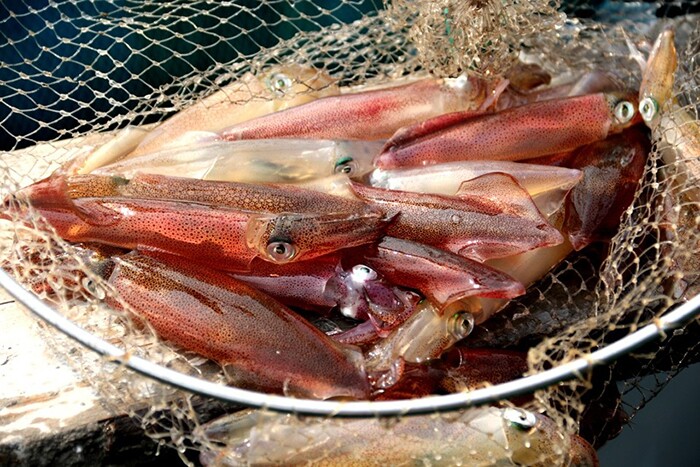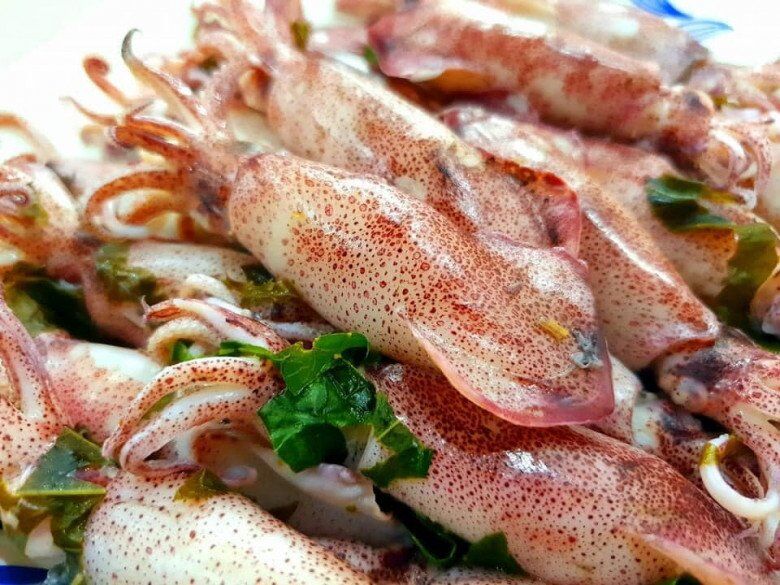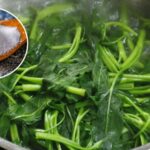How to Choose Fresh Squid
– Avoid squid with peeling skin: This is a sign that the squid is old or has been soaked, and its quality is no longer good. The squid’s skin will peel off in spots, the color will be less vibrant, and the flesh will be mushy when cooked.
– Choose squid with the following characteristics: A transparent body, clear eyes, firm flesh, and no signs of softness or purple-tinged fins. When touched, it should still feel slightly elastic.
– Freshly caught squid usually has a white, transparent body. As it comes out of the water, the squid will gradually change color, going from transparent to white to light pink. The stage when the squid is “blushing” (changing color slightly) is when it is at its freshest and of the best quality.

– If you can’t get your hands on fresh squid, opt for frozen squid that has been frozen at the right time, which is when the squid is just starting to change color (“blushing”) and is still at its freshest. When thawed properly, this squid will retain its crispness, sweetness, and aroma, just like freshly caught squid.
– Avoid buying squid that has been soaked in water or ice for too long. Squid is a soft-bodied creature with a strong ability to absorb freshwater. Soaking it for a few hours can cause it to expand by several ounces. When cooked, these squid tend to release water, become mushy, and lose their characteristic sweetness and crispness.
How to Boil Squid to Perfection, Every Time
Preparation:
– Fresh squid.
– Lemongrass, ginger, and Vietnamese coriander (optional).
Instructions:
– Pound or finely chop the ginger. Peel and cut the lemongrass into sections, then pound it. Ginger and lemongrass are key ingredients to ensuring your boiled squid is fragrant and not fishy.
– Add water to a pot, along with the ginger and lemongrass. Note that the water level should be higher than the squid as it will expand during boiling.
– Bring the water to a boil, then gently place the squid into the pot. Be careful not to stir the squid, as this may cause its tentacles to fall off.
– Cover the pot and wait for the water to boil again. If you like, add some Vietnamese coriander for extra fragrance.
Depending on the size of the squid, adjust the cooking time: for small squid, boil for 1 minute after the water comes back to a boil; for medium-sized squid, boil for 2 minutes; and for large squid, boil for 3 minutes.

Alternatively, keep an eye on the squid, and as soon as it looks round and plump, remove it from the heat. If you want to be extra sure, you can boil each size for an additional 30 seconds to 1 minute. However, be careful not to overboil, as this will make the squid tough and chewy.
Note: Some experienced cooks suggest adding a little chili paste and lime juice to the boiling water to make the squid even more delicious and crispy.

Good luck, and happy cooking!
Why Does Adding Salt to Boiling Vegetables Keep Them Green and Bright?
Introducing the secret to vibrant, healthy-looking boiled vegetables: a pinch of salt. It’s a widely adopted trick to add salt to the boiling water, resulting in greener, more vibrant veggies. But the question remains: why does salt have this magical effect? Unraveling this mystery is key to unlocking the full potential of your culinary creations.
The Smart Way to Keep Your Home Fresh and Clean: A Secret Ingredient for Your Vacuum Cleaner
Introducing a simple yet effective way to transform your vacuuming experience – a burst of spice! According to experts, adding a dash of spice to your vacuum cleaner can work wonders. Not only will it eliminate odors and leave your home smelling fresh, but it also has antibacterial properties. Imagine a clean and fragrant home, all achieved with a simple twist of flavor. It’s time to spice up your cleaning routine and take it to the next level!



































